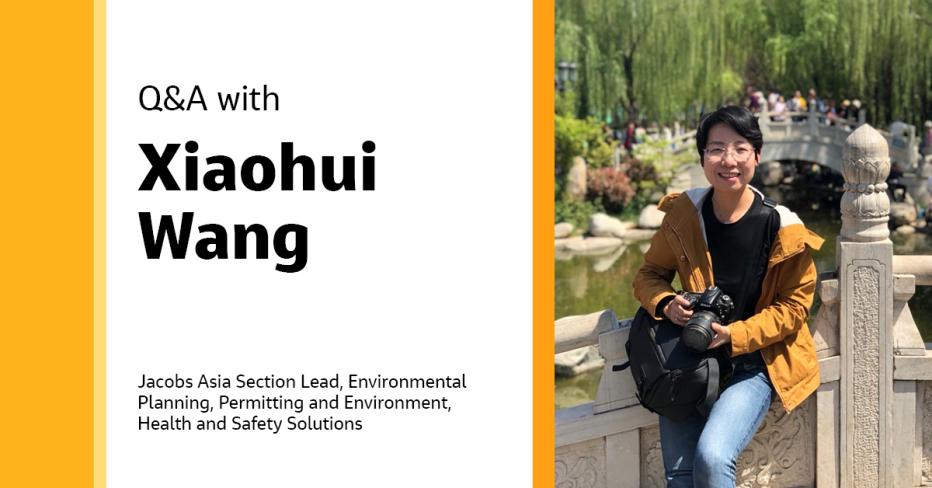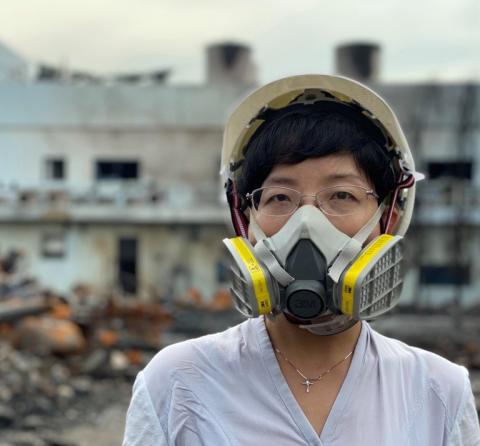
Hi, Xiaohui! Can you tell us about your role and what you’re most passionate about? How’s the work you do helping deliver climate response and consulting & advisory solutions for our clients?
I lead development of environmental planning; permitting; and environment, health and safety (EHS) solutions for our clients in Asia. Along with taking care of the day-to-day operations of this section and connecting people from six countries in Asia, I lead a group of our environmental teammates providing advisory and solutions to clients to solve environmental issues and better plan the environmental and sustainability aspects at the beginning of their development projects.
I also work collaboratively with teams in advanced facilities, life sciences, energy & power, transportation and water to integrate environmental planning into their projects.
In your opinion, what are some of the biggest environmental challenges we’re facing?
There are several major environmental challenges facing Asia, such as air pollution, water scarcity, deforestation, biodiversity loss and climate change.
Due to factors such as rapid industrialization, increasing transportation needs and the burning of fossil fuels, many countries in Asia are facing air pollution and water scarcity. This is leading to serious health problems and intensifying competition for water resources.
Deforestation is another significant problem in many Asian countries, driven by the need for land for agriculture and urbanization, as well as the demand for timber and other forest products. Asia is home to some of the world's largest tropical rainforests, many of which face the threat of habitat loss, over-exploitation, pollution and climate change. The resulting loss of biodiversity could have serious implications for the functioning of ecosystems and human well-being.
Asia is also particularly vulnerable to the impacts of climate change, including sea-level rise, increased frequency and intensity of extreme weather events and changes in rainfall patterns. These impacts are likely to have significant social, economic and environmental consequences for the region, if left unchecked.
When it comes to creating a low-carbon future in Asia, what do you think are the biggest challenges?
The main barriers to transitioning from fossil fuels to renewable energy are related to technology and finance. Moreover, many Asian countries are experiencing rapid economic growth. This growth could lead to a rise in energy consumption which, if left unchecked, may cause an increase in greenhouse gas emissions, deforestation and habitat loss. Striking a balance between achieving economic development and ensuring low-carbon emissions is emerging as a major challenge.
Can you tell us more about the environmental solutions and projects you’re working on with our clients?
I am proud that over the last two years, we have worked with clients across sectors to deliver interesting environmental projects with smart, sustainable solutions, contributing to creating a low-carbon future for the region.
For instance, we carried out a low-carbon study for a global technology firm, an energy and water efficiency study for a pharmaceutical facility, a safety risk red flag review for a green hydrogen production and storage in salt cavern project, a climate risk vulnerability assessment for a technology company with multiple sites across several Asian countries, an embodied carbon assessment for a data center, and greenhouse gas carbon accounting for a global liquified natural gas infrastructure engineering and servicing client.
How did you start off your career and what sparked your interest in a career in STEAM?
I started my career as a water process engineer specialized in power plant engineering design. I moved to Singapore in 2001 to pursue my master’s and PhD in environmental engineering. Since joining Jacobs after graduation, I have been exposed to a range of environmental subjects, including pollution controls for air, noise and water, land contamination as well as safety risk assessment of hazardous substances for various industrial facilities.
What sparked my interest in environmental studies is its multidisciplinary nature. It encompasses biological, cultural, social and physical components…subjects spanning science, geography, economics, statistics, health, technology, population and ecology – they’re all related. Environmental studies has areas that make me think, “I know what I don’t know,” and “I don’t know what I don’t know.” This really keeps my curiosity alive as there is always something to explore further.
A few years ago, when climate response and energy transition became a hot topic, I became curious about energy efficiency since it applies to every aspect of the industrialized world. Instead of staying at the surface of this topic, I registered myself in the Singapore Certified Energy Manager (SCEM) Professional Program to gain in-depth knowledge systematically. In two years, I passed the exam consisting of six modules. Today, as an SCEM registered with Singapore National Environment Agency, I provide better solutions to our clients.
“What sparked my interest in environmental studies is its multidisciplinary nature. It encompasses biological, cultural, social and physical components…subjects spanning science, geography, economics, statistics, health, technology, population and ecology – they’re all related.”
People would be surprised to know that I...
Can do a front spilt but not a push-up…and that my two boys still insist that I give them a haircut at home so they can watch a movie at the same time. They have been my only two “home salon” customers for the last 14/15 years!
If you aren’t working, what would we be most likely to find you doing?
You may find me practicing yoga and photography, reading and traveling.
Also, I started to grow more indoor plants at home since the COVID-19 pandemic, but I’m still facing a learning curve…learning how to nurture and save plants and how not to over-water them.
I plan to continue learning Tai Chi as well.
Proudest career moment at Jacobs?
When our team receives appreciation and compliments from our clients. For instance, we recently received an email from a client stating that they found us to be the most skillful consultant team for the project.
What do you enjoy most about being part of #OurJacobs?
Whenever I encounter technically challenging issues, I know I can tap into the large, global talent pool of subject matter experts at Jacobs.
Join #OurJacobs team
What drives you drives us as we work to build a better world – together. At Jacobs, every day is an opportunity to make the world better, more connected, more sustainable. We’re always looking for dynamic and engaged people to join our team. Bring your passion, your ingenuity and your vision.















































